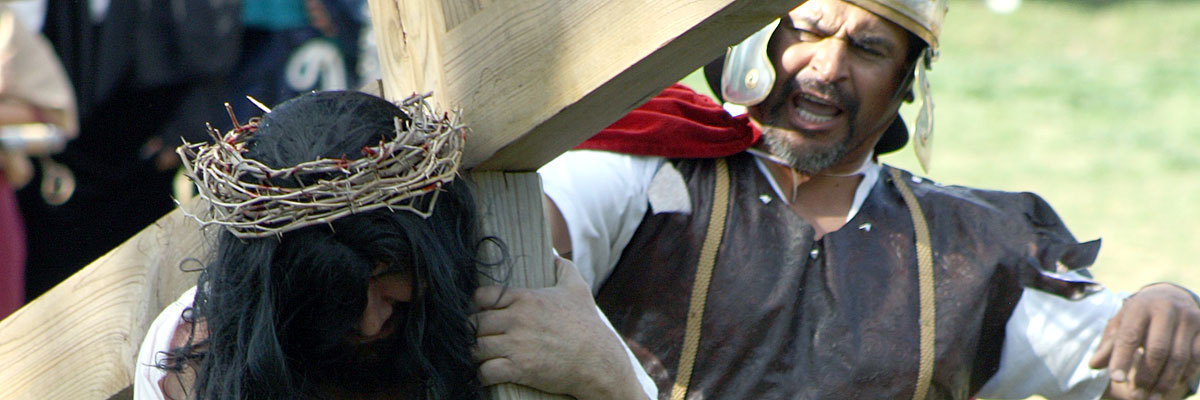Official Website of the
Catholic Diocese of Little Rock
Join us in celebrating holiest week of year
Published: April 7, 2017
Holy Week Schedule in Arkansas
Click on the link above to find the schedule for Holy Week events in Catholic parishes across the Diocese of Little Rock. Every effort was made to ensure accuracy. Consult a parish directly for last minute changes. If not listed, please contact your parish.
Easter Triduum
Lent ends with the celebration of the Easter Triduum, which is the most sacred time of the liturgical year. The word "triduum" comes from the Latin word meaning "three days." It takes place from the evening of Holy Thursday to the evening of Easter Sunday. The liturgical celebrations of the Easter Triduum are rich in symbolism and flow from one to the other in a seamless way. Liturgically, they are "one day unfolding for us the unity of Christ's Paschal Mystery." For this reason, Catholics are encouraged to attend all the liturgies to the triduum. See the Holy Week Schedule to find Mass times and other Triduum activities in your area. To learn more, see Our Sunday Visitor's Triduum Family Activities and Guide to Holy Week.
Bishop Anthony B. Taylor will celebrate the triduum at the Cathedral of St. Andrew in Little Rock. The schedule is as follows: Holy Thursday Mass of the Lord's Supper, April 13 at 6 p.m.; Good Friday Passion of the Lord, April 14 at 12:05 p.m.; and the Easter Vigil Mass (Holy Saturday), April 15 at 8 p.m. Easter Sunday Masses will be celebrated April 16 at 8:30 a.m. and 12:05 p.m. To learn about the meaning and symbolism of these special celebrations, see the articles below, beginning with Palm Sunday.
Palm Sunday
"'The very large crowd spread their cloaks on the road, while others cut branches from the trees and strewed them on the road. The crowds preceding him and those following kept crying out and saying: “Hosanna* to the Son of David; blessed is he who comes in the name of the Lord; hosanna in the highest.'" — Matthew 21:8-9
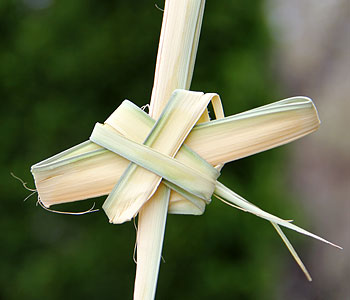 Bishop Taylor celebrated Palm Sunday Mass at the Cathedral of St. Andrew in Little Rock at 12:05 p.m. Sunday, April 9. On Palm Sunday, also known as Passion Sunday, Catholics reenact the events of Jesus' triumphant entry into Jerusalem to mark the beginning of Holy Week, which commemorates the passion, death and resurrection of Jesus, who triumphed over death and made our salvation possible.
Bishop Taylor celebrated Palm Sunday Mass at the Cathedral of St. Andrew in Little Rock at 12:05 p.m. Sunday, April 9. On Palm Sunday, also known as Passion Sunday, Catholics reenact the events of Jesus' triumphant entry into Jerusalem to mark the beginning of Holy Week, which commemorates the passion, death and resurrection of Jesus, who triumphed over death and made our salvation possible.
"As we begin this Holy Week, we lift up palms to remind ourselves of just how fickle we are. We honor the Lord one day and yet are fully capable of betraying him the next," Bishop Taylor said in his homily. Read more.
The blessed palm frond that everyone receives at this Mass is a sacramental to take home. Traditionally Catholics keep their palms near or behind a crucifix, on a prayer altar or with their Bible. Keeping the palm serves as a reminder to remember Jesus' Passion and follow in his footsteps to carry the crosses in our own lives. Catholics are asked to bring their palms back a year later to be burned so the ashes can be used on Ash Wednesday to begin Lent anew.
For those who don't return their palms to be burned for Ash Wednesday and want to dispose of them properly, the same rule applies as with any blessed object. They should never be disposed of in the trash. The proper way is by burning or burial. With blessed palms, it would be appropriate to bury them in a flower garden at your home.
From medieval times, people have believed that blessed palms formed into the shape of a cross would protect them from danger. To learn more, see the symbolism of palms in the ancient world or learn how to make a palm cross.
Chrism Mass
The bishop celebrated the Chrism Mass at the Cathedral on Monday, April 10 at 5:30 p.m. Priests serving across the diocese concelebrate this Mass, during which they also renew their commitment to priestly service. Oils to be used statewide in the coming year are presented for the bishop's blessing. These include the oil for the sick, used in anointing the sick; the oil for catechumens, used during baptism; and the oil for the sacred chrism, which is the primary anointing oil.
 The word "chrism" means "consecrated oil." It is used in the sacraments of initiation and holy orders as well as special acts of dedication, such as consecrating a new altar and blessing church bells upon their installation.
The word "chrism" means "consecrated oil." It is used in the sacraments of initiation and holy orders as well as special acts of dedication, such as consecrating a new altar and blessing church bells upon their installation.
"For centuries, chrism oil has been a symbol of God’s overflowing grace and generosity. It’s a multi-sensory reminder of the goodness of creation, and of people and objects that are set apart from that creation to serve a sacred purpose." Like all sacred oils, chrism oil is typically made from olive oil. But unlike other sacramental oils, chrism is scented, usually with the essential oil of balsam, giving it a woody, pine-like fragrance. To learn more, see Chrism Mass Symbols and Meaning.
In his homily, Bishop Taylor explained the purpose of anointing. "By means of these anointings we become another 'Christ.' That is why we are called 'Christians' — 'Christ' is Greek for 'anointed one' and we've been anointed. ... If we are to be 'another Christ — truly a Christian — that means that Christ's mission becomes our mission."
According to Our Sunday Visitor, in many cultures the Monday, Tuesday and Wednesday of Holy Week are set aside for a thorough housecleaning in preparation for Easter. This tradition probably came from the Jewish custom of ritual cleaning before Passover.
Holy Thursday
On Holy Thursday, we celebrate the Mass of the Lord's Supper, during which we mark the institution of the Eucharist and the washing of feet. Both were commands of Jesus. "Amen, amen, I say to you, unless you eat the flesh of the Son of Man and drink his blood, you do not have life within you." (John 6:53)
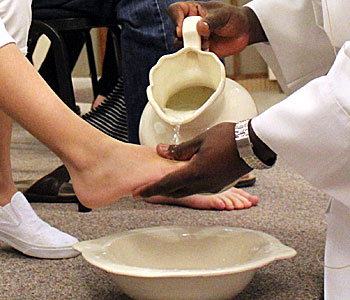 And "If I, therefore, the master and teacher, have washed your feet, you ought to wash one another's feet. I have given you a model to follow, so that as I have done for you, you should also do." (John 13:14-15)
And "If I, therefore, the master and teacher, have washed your feet, you ought to wash one another's feet. I have given you a model to follow, so that as I have done for you, you should also do." (John 13:14-15)
Maundy Thursday, the traditional title, reflects this need to serve. It comes from the Latin, "mandatum novum" ("a new command"), which is based on John 13:34: "I give you a new commandment: love one another. As I have loved you, so you also should love one another."
Because Mass is not celebrated on Good Friday, extra consecrated Hosts are reserved after Communion for the Good Friday service. These Hosts are carried in a solemn procession for reservation in the tabernacle.
During the procession, Tantum Ergo Sacramentum or another Eucharistic song is sung. Recalling Jesus' request of his disciples to stay awake and pray in Gethsemane before his arrest (Luke 22:39-46), parishioners are invited to stay and pray before the Blessed Sacrament. The Mass concludes quietly as the altar is stripped in preparation for Good Friday.
A special collection to support seminarian education is taken up in all parishes on Holy Thursday. Look for the envelope in your parish or donate online. Before Mass, consider visiting area churches to say a prayer. Traditionally, Catholics visited churches to pray on Holy Thursday. This evolved from the practice of Christian pilgrimages to the holy sites where Jesus lived, preached and experienced his passion, death and resurrection.
Good Friday
On Good Friday of the Lord's Passion, we fast, abstain and relive Jesus' suffering and death so we never forget God's unconditional love and desire for us to be saved. "For God so loved the world that he gave his only Son, so that everyone who believes in him might not perish but might have eternal life." (John 3:16)
This is the only day of the year we do not celebrate Mass. This sober service includes the Liturgy of the Word, general intercessions, veneration of the cross and reception of the Eucharist.
 As we enter into Christ's passion and death, today's second reading offers a powerful reflection: "In the days when Christ was in the flesh, he offered prayers and supplications with loud cries and tears to the one who was able to save him from death, and he was heard because of his reverence. Son though he was, he learned obedience from what he suffered; and when he was made perfect, he became the source of eternal salvation for all who obey him." (Hebrews 5:7-9)
As we enter into Christ's passion and death, today's second reading offers a powerful reflection: "In the days when Christ was in the flesh, he offered prayers and supplications with loud cries and tears to the one who was able to save him from death, and he was heard because of his reverence. Son though he was, he learned obedience from what he suffered; and when he was made perfect, he became the source of eternal salvation for all who obey him." (Hebrews 5:7-9)
Many parishes offer the stations of the cross on Good Friday. Some perform a live reenactment of Jesus' passion and death. Visit Arkansas Catholic's website to find a schedule of these events. If unable to attend in person, you are welcome to take part in this devotion online.
We offer the Via Dolorosa (Way of the Cross) in Jerusalem, which offers reflections from Pope Francis and photos of the stations in Jerusalem; and the Way of the Cross: Stations and Meditations from Arkansas, which include video reflections from Arkansans and illustrations from both indoor and outdoor stations at churches and monasteries throughout the state. You may also reflect on the "Stabat Mater" (the "Mother was Standing"), a 13th-century Catholic hymn about Mary's pain at the foot of her Son's cross.
In addition to the traditional disciplines of fasting and abstinence, the diocese is inviting Catholics in Arkansas to fast from digital media on Good Friday and offer up the sacrifice for those marginalized and neglected, reflecting on Jesus' parable of the Last Judgment in Matthew 25:31-46. And the Holy Father is asking Catholics worldwide to give to the Pontifical Good Friday Collection. These donations help preserve the holy shrines for pilgrims and support the pastoral, charitable, educational and social works of Christians in the Holy Land.
Holy Saturday
On Holy Saturday, we gather for the climax of the Easter Triduum. "On this holy night, the Church keeps watch, celebrating the resurrection of Christ in the sacraments and awaiting his return in glory. It is the turning point of the triduum, the Passover of the new covenant, which marks Christ's passage from death to life."
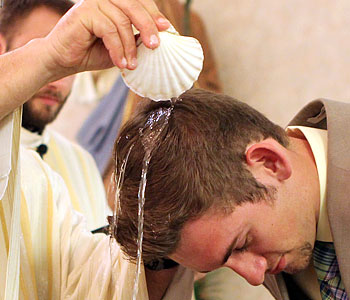 Known as the "mother of all vigils," the Easter Vigil Mass takes places after sundown and before daybreak, thus beginning and ending in darkness. The biblical themes of light removing darkness and life overcoming death runs through the entire Mass, which consists of four main parts: the Service of Light, the Liturgy of the Word, Liturgy of Baptism and Liturgy of the Eucharist.
Known as the "mother of all vigils," the Easter Vigil Mass takes places after sundown and before daybreak, thus beginning and ending in darkness. The biblical themes of light removing darkness and life overcoming death runs through the entire Mass, which consists of four main parts: the Service of Light, the Liturgy of the Word, Liturgy of Baptism and Liturgy of the Eucharist.
"The events we celebrate today can be summarized by a single phrase: 'The light shines in the darkness and the darkness has not overcome it.' We find this phrase in the prologue of John's Gospel (1:5) and it finds fulfillment in the events of Jesus' death and resurrection," Bishop Taylor explained in his homily.
Adults will join the Catholic Church by receiving the sacraments of baptism, confirmation and Eucharist in parishes worldwide on this night. Witness the miracle of new life in Christ by attending the Easter Vigil Mass in your area. The list of all those entering the Church in Arkansas may be found in the April 15 issue of Arkansas Catholic.
Did you get your new Easter outfit yet? "From the time of the early Christians, the newly baptized wore white garments made from new linen. In medieval times, it became a tradition for people to wear new clothes on Easter Sunday, symbolizing the 'new life' that comes with the Resurrection. In some places it was believed that bad luck would come to those who could afford new Easter clothes but refused to buy them."
Easter Sunday
Easter Sunday is the greatest of all Sundays, and Easter Time is the most important of all liturgical seasons. Easter is the celebration of the Lord's resurrection from the dead. All faith flows from faith in the resurrection.
"The Resurrection of Jesus is the crowning truth of our faith in Christ, a faith believed and lived as the central truth by the first Christian community; handed on as fundamental by Tradition; established by the documents of the New Testament; and preached as an essential part of the Paschal mystery along with the cross: Christ is risen from the dead! Dying, he conquered death; To the dead, he has given life." (Catechism of the Catholic Church, nos. 638-639)
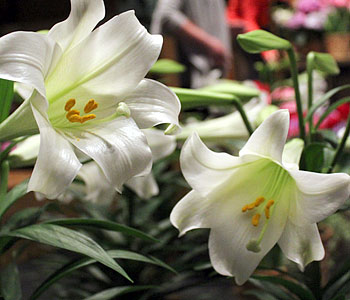 The word "Easter" comes from Old English, meaning the "East." The sun, which rises in the East, is a symbol for Christians of the rising Christ, who is the true Light of the world. The Paschal Candle is a key symbol of this divine light, which is Christ. It is kept near the ambo throughout the Easter season and lit for all liturgical celebrations.
The word "Easter" comes from Old English, meaning the "East." The sun, which rises in the East, is a symbol for Christians of the rising Christ, who is the true Light of the world. The Paschal Candle is a key symbol of this divine light, which is Christ. It is kept near the ambo throughout the Easter season and lit for all liturgical celebrations.
"The Resurrection above all constitutes the confirmation of all Christ's works and teachings. All truths, even those most inaccessible to human reason, find their justification if Christ by his resurrection has given the definitive proof of his divine authority, which he had promised. (no. 651)
So what does the Easter Bunny have to do with Easter? Folklore suggests the custom came from Germany in the 1500s. Rabbits were considered the most fertile animals and were symbols of abundant new life in spring. The Easter Bunny was said to lay red eggs on Maundy Thursday and additional colored eggs the night before Easter. Learn more from Catholic Culture.
Our Sunday Visitor explains that decorating eggs was a pagan symbol of rebirth at springtime for many cultures. Christians adopted the colored egg as a symbol of new life to represent the resurrection. The tradition of decorating with Easter lilies came into practice in the 1800s. This white flower, a symbol of purity and new life, also became a symbol of the resurrection.





